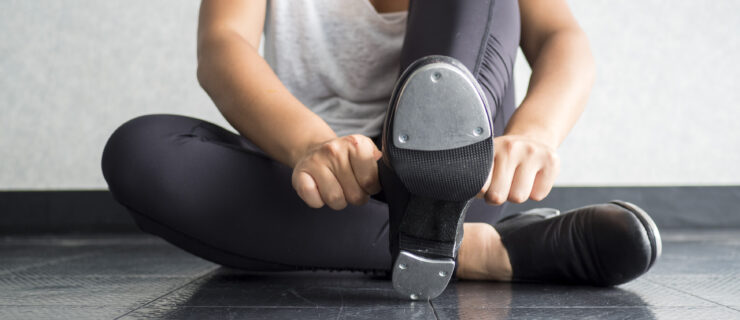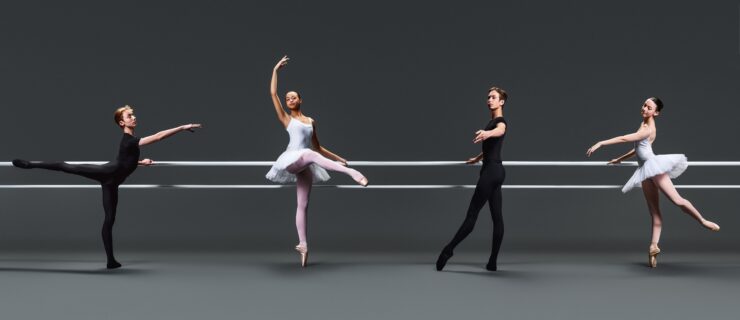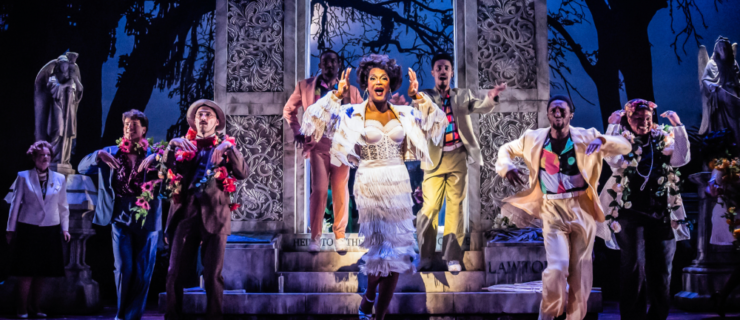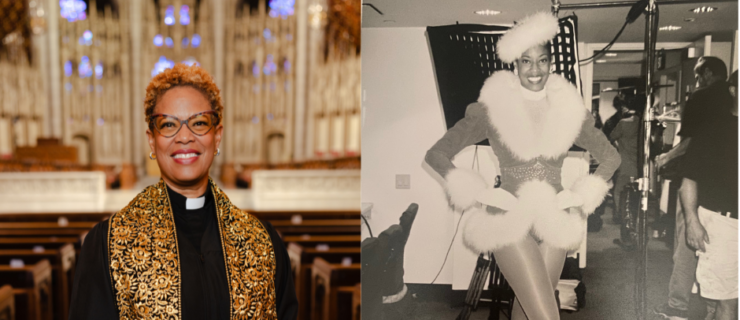The Queen of Quirk
Photo by Jayme Thornton (2)
When Celia Rowlson-Hall found out she would be choreographing for HBO’s “Girls,” she felt like she was in the right place. Woven into the drama of last season’s “Beach House” episode, her coy, catchy moves had the actors chugging, grapevining and otherwise grooving around kitchen counters and living room furniture. For those 45 seconds, their characters—four feuding friends—managed to get along.
“The job was serendipitous in terms of the style,” says Rowlson-Hall. “I mean, making up a dance in the living room is really all I like to do anyway.”
She’s joking, but not entirely. Much of what this Brooklyn-based choreographer, filmmaker and performer makes has the impromptu, wacky charm of the stuff you do at home when no one’s watching. And her passion for telling stories through film and movement is no less zealous than that of a kid staging a backyard musical. But her work is also remarkably sophisticated, in all of its onscreen forms: her own surreal, wordless short films; choreography for music videos and commercials; off-the-cuff dances on Instagram; and, coming soon, her first feature-length film, MA, a silent movie about a virgin mother’s pilgrimage across the American Southwest. (More on that later.) At a time when many people would sooner spend $300 on an iPad than on tickets to the ballet, she’s telling smart, whimsical stories that dance across our devices.
Rowlson-Hall, 30, started out in contemporary dance, but the “highs and heartbreaks” of live performance, she says, became too taxing: all that work and emotional investment for just a few fleeting shows. “Maybe I’m too sentimental,” she says, “but I needed something to hold on to.”
Her path isn’t easy to trace. Slipping between high-profile gigs and DIY adventures, Rowlson-Hall is something of a chameleon. Her clients range from independent designers to big-name brands (Kate Spade, Lee Jeans), from cult electronic artists to popular Indie bands (MGMT, Sleigh Bells). When “Girls” writer and star Lena Dunham appeared on the cover of Vogue, Rowlson-Hall choreographed the cheeky companion video. She seems to be that magazine’s go-to dance consultant, having also directed a Vogue video of the Memphis jookin’ virtuoso Lil Buck.
Her own films, in which she often stars—all spindly, elegant limbs and wild blue eyes—lure the viewer into strange, hyper-saturated worlds unto themselves, where movement does the talking in both loud and subtle ways. They can be disturbing or disarming, garish or achingly poignant. A few of her shorts have earned the exclusive “Staff Pick” stamp at Vimeo, and two of those made it to South by Southwest last year: her haunting si nos dejan and hilarious The Audition, an absurdist one-take perhaps inspired by her own auditioning past.
It’s hard to imagine anyone seeing “zero professional promise” in Rowlson-Hall. But such was the assessment, as she remembers it, from her professors at the University of North Carolina School of the Arts, where she spent her college years. (She grew up in the tiny town of Urbanna, Virginia.) While most dance majors auditioned for the work of guest artists and spent their afternoons in rehearsal, Rowlson-Hall, not the most conventionally technical dancer—as she puts it, “I move a little weird”—never made the cut.
“I could have been done with classes by 3 pm and messed around the rest of the day,” she recalls. “But that’s when I started to really choreograph. I made my own work.”
Upon graduating in 2006, Rowlson-Hall plunged into New York City life, exploring every creative outlet in sight. The so-called awkwardness that had hindered her in college endeared her to a couple of audacious choreographers: Faye Driscoll and Monica Bill Barnes. “She had this gangliness,” Driscoll says, “but it became for me the thing that was so beautiful about her.” Driscoll also admired her up-for-anything attitude, “this willingness to try, to just go for things, whether or not they ended up being a horrible idea. She’s really just an idea machine.” Barnes, who mentored Rowlson-Hall through Lincoln Center’s Kenan Fellowship, an opportunity for emerging artists from UNCSA, describes her as “an incredibly genuine performer, with these bold instincts and a sense of how to carry them out.”
Rowlson-Hall danced with Driscoll and Barnes for several years, even winning a Bessie Award as a performer in Driscoll’s 837 Venice Blvd. But her interests had always varied, darting between dance, photography and fashion. Through a growing network of artist friends willing to teach her new skills—and through modeling jobs that connected her with commercial casting directors—she discovered that her passions could converge in a single, less ephemeral medium: film. The first time she walked onto a music video set, she says, “it felt like home.”
“I think filmmaking in itself is a bit of a dance,” she says, “whether it’s how the camera is moving or how you’re editing; it all has momentum and lyricism and tempo.”
Her versatility—her fluency in choreographing both for and with the camera—makes her a sought-after collaborator. As “Girls” director Jesse Peretz puts it, “I could tell I was working with someone who had not only a choreographer’s brain but also a director’s brain.” Other colleagues, like the clothing designer Rachel Antonoff, for whom Rowlson-Hall directed a fanciful five-minute promo, note her almost telepathic intuition. “She has this ability to extract what’s in your head,” Antonoff says, “to take something you weren’t able to totally verbalize and not only verbalize it perfectly, but make it better than you ever thought it could be.”
Rowlson-Hall also has an uncanny way of rallying people behind her ideas—no matter how out-there they may seem. Last year she raised $50,000 on Kickstarter to fund MA, her most ambitious project yet, in which she’ll play the title role: “a virgin mother on a pilgrimage to Las Vegas to give birth to our savior.” (She’s on location in Arizona and Nevada this month.) The choreographer Sydney Skybetter was among her backers. “At a time when Kickstarter had gotten so obnoxious and noisy, she commanded it for something meaningful and highly personal and utterly nonsensical,” he says. “I honestly don’t understand what she’s doing, and it’s great.”
Rowlson-Hall admits that she doesn’t completely understand either. But she loves the journey of finding out, and she knows what fascinates her: the untold stories of women—“the mother of the hero,” she says—and myths of all kinds, including biblical ones. (Raised in a Christian Scientist family, she has since settled into a broader kind of spirituality.) In MA, those fascinations collide with the help of a sprawling creative team. Her cast features the dancers Jason Kittelberger (formerly of Cedar Lake) and Bobbi Jene Smith (formerly of Batsheva).
As untamed as her work can be—see the punch-bowl scene in Prom Night or the confectionary ghost in Piñata—Rowlson-Hall loves to tunnel into a simple idea. At a residency last May, she spent days refining how Ma will walk: How does she carry herself? Where is her focus? Outside the studio, she keeps her eyes peeled for naturally occurring choreography. On a recent trip to India, from the 30th floor of a hotel, she spotted four boys frolicking on the street below. “I swear, it was more beautiful than a Cunningham piece,” she says. From that image, a section of MA was born.
As a performer in her own work, Rowlson-Hall likes to capture herself in a single take. It’s like being onstage: no second chances. “I do miss performing live,” she says, “so in my filmmaking, I try to bring a sense of that aliveness—try to get the best of both worlds.”
Siobhan Burke, a former
Dance Magazine editor, is a dance critic for The New York Times.
Four photos from top: Making a video with Hamish Bowles, international editor at large of
Vogue; Rowlson-Hall’s choreography for “Girls”; performing in her short films All the World’s a Stage and Mariah’s Lollipop. All photos courtesy Rowlson-Hall, except “Girls” by Mark Schafer/HBO, Courtesy HBO.




